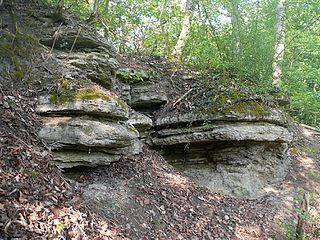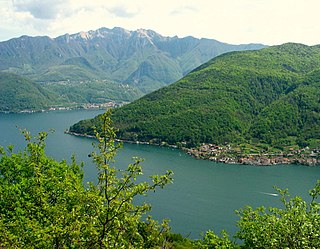
The Ediacaran Period is a geological period that spans 96 million years from the end of the Cryogenian Period 635 million years ago (Mya), to the beginning of the Cambrian Period 538.8 Mya. It marks the end of the Proterozoic Eon, and the beginning of the Phanerozoic Eon. It is named after the Ediacara Hills of South Australia.

Conodonts are an extinct group of agnathan (jawless) vertebrates resembling eels, classified in the class Conodonta. For many years, they were known only from their tooth-like oral elements found in isolation and now called conodont elements. Knowledge about soft tissues remains limited. They existed in the world's oceans for over 300 million years, from the Cambrian to the beginning of the Jurassic. Conodont elements are widely used as index fossils, fossils used to define and identify geological periods. The animals are also called Conodontophora to avoid ambiguity.
The Furongian is the fourth and final epoch and series of the Cambrian. It lasted from 497 to 485.4 million years ago. It succeeds the Miaolingian series of the Cambrian and precedes the Lower Ordovician Tremadocian Stage. It is subdivided into three stages: the Paibian, Jiangshanian and the unnamed 10th stage of the Cambrian.
The Rhaetian is the latest age of the Triassic Period or the uppermost stage of the Triassic System. It was preceded by the Norian and succeeded by the Hettangian. The base of the Rhaetian lacks a formal GSSP, though candidate sections include Steinbergkogel in Austria and Pignola-Abriola in Italy. The end of the Rhaetian is more well-defined. According to the current ICS system, the Rhaetian ended 201.3 ± 0.2 Ma.

In the geologic timescale, the Anisian is the lower stage or earliest age of the Middle Triassic series or epoch and lasted from 247.2 million years ago until 242 million years ago. The Anisian Age succeeds the Olenekian Age and precedes the Ladinian Age.

The Induan is the first age of the Early Triassic epoch in the geologic timescale, or the lowest stage of the Lower Triassic series in chronostratigraphy. It spans the time between 252.902 Ma and 251.2 Ma. The Induan is sometimes divided into the Griesbachian and the Dienerian subages or substages. The Induan is preceded by the Changhsingian and is followed by the Olenekian.

The Ladinian is a stage and age in the Middle Triassic series or epoch. It spans the time between 242 Ma and ~237 Ma. The Ladinian was preceded by the Anisian and succeeded by the Carnian.
Paibi, a village in Paibi Township, Huayuan County, Xiangxi Tujia and Miao Autonomous Prefecture Hunan, China, is the location of the Global Boundary Stratotype Section and Point (GSSP) which marks the boundary between the third and Furongian epochs of the Cambrian Period on the geologic time scale. Paibi was selected over the Kyrshabakty River section, Malyi Karatau, Kazakhstan, and the GSSP was ratified by the International Union of Geological Sciences in late 2003. It established the first formally agreed upon subdivision of the Cambrian. The village gives its name to the Paibian Age in the Cambrian Period.
The Lau event was the last of three relatively minor mass extinctions during the Silurian period. It had a major effect on the conodont fauna, but barely scathed the graptolites. It coincided with a global low point in sea level, is closely followed by an excursion in geochemical isotopes in the ensuing late Ludfordian faunal stage and a change in depositional regime.

The end-Botomian mass extinction event, also known as the late early Cambrian extinctions, refer to two extinction intervals that occurred during Stages 4 and 5 of the Cambrian Period, approximately 513 to 509 million years ago. Estimates for the decline in global diversity over these events range from 50% of marine genera up to 80%. Among the organisms affected by this event were the small shelly fossils, archaeocyathids, trilobites, brachiopods, hyoliths, and mollusks.
Trilobites are used as index fossils to subdivide the Cambrian period. Assemblages of trilobites define trilobite zones. The Olenellus-zone has traditionally marked the top of the Lower Cambrian, and is followed by the Eokochaspis zone.
The Norian is a division of the Triassic Period. It has the rank of an age (geochronology) or stage (chronostratigraphy). The Norian lasted from ~227 to 208.5 million years ago. It was preceded by the Carnian and succeeded by the Rhaetian.
The Steptoean Positive Carbon Isotope Excursion (SPICE) was a geological event which occurred about 494.6 million years ago near the beginning of the International Furongian Epoch of the Cambrian Period. The SPICE event was a positive shift in carbon isotope (δ13C) values which lasted for around 2 to 4 million years. This shift is interpreted to be a global disturbance in the carbon cycle, affecting both the ocean and atmosphere. Regional sea level changes, a rise in sea water temperatures, and trilobite and brachiopod extinctions are associated with the SPICE event, although the exact mechanism(s) driving these events is still unconfirmed.
Stage 10 of the Cambrian is the still unnamed third and final stage of the Furongian series. It follows the Jiangshanian and precedes the Ordovician Tremadocian Stage. The proposed lower boundary is the first appearance of the trilobite Lotagnostus americanus around 489.5 million years ago, but other fossils are also being discussed. The upper boundary is defined as the appearance of the conodont Iapetognathus fluctivagus which marks the beginning of the Tremadocian and is radiometrically dated as 485.4 million years ago.
Cambrian Series 2 is the unnamed 2nd series of the Cambrian. It lies above the Terreneuvian series and below the Miaolingian. Series 2 has not been formally defined by the International Commission on Stratigraphy, lacking a precise lower boundary and subdivision into stages. The proposed lower boundary is the first appearance of trilobites which is estimated to be around 521 million years ago.
The Carnian pluvial episode (CPE), often called the Carnian pluvial event, was an interval of major changes in global climate and the dominant plants and animals, or biota, of Earth that occurred during the Carnian age of the late Triassic period. It occurred over several million years, across the boundary between the Julian and Tuvalian subages of the Carnian. It led to the evolution and diversification of many important groups of life, including the first dinosaurs, lepidosaurs, and calcium-containing microfossils, as well as a wider array of conifers and stony corals. The CPE also led to the extinction of many aquatic invertebrate species, especially among the ammonoids, conodonts, bryozoa, and crinoids.
Westergaardodina is a species-rich genus of spine, U or W-shaped paraconodont known from Middle Cambrian to Lower Ordovician strata.
Utahconus is an extinct genus of conodonts.
Conodonts are an extinct class of animals whose feeding apparatuses called teeth or elements are common microfossils found in strata dating from the Stage 10 of the Furongian, the fourth and final series of the Cambrian, to the Rhaetian stage of the Late Triassic. These elements can be used alternatively to or in correlation with other types of fossils in the subfield of the stratigraphy named biostratigraphy.

The Winneshiek Shale is a Middle Ordovician (Darriwilian-age) geological formation in Iowa. The formation is restricted to the Decorah crater, an impact crater near Decorah, Iowa. Despite only being discovered in 2005, the Winneshiek Shale is already renowned for the exceptional preservation of its fossils. The shale preserves a unique ecosystem, the Winneshiek biota, which is among the most remarkable Ordovician lagerstätten in the United States. Fossils include the oldest known eurypterid, Pentecopterus, as well as giant conodonts such as Iowagnathus and Archeognathus.






